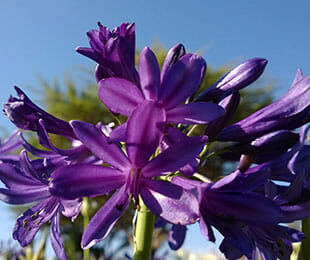Exactly how to Plant and Maintain Agapanthus in Your Yard
Exactly how to Plant and Maintain Agapanthus in Your Yard
Blog Article
Understanding the Art of Agapanthus Care: Necessary Actions for Healthy And Balanced Growth and Dynamic Blooms
In the realm of horticulture, the growing of agapanthus stands as a fulfilling venture for those who look for to support these classy blooming plants. From picking the best variety to grasping pruning strategies, the journey in the direction of cultivating growing agapanthus plants is multifaceted and holds the essential to opening the full potential of these agricultural treasures.

Selecting the Right Agapanthus Selection

When selecting the appropriate Agapanthus variety for your garden, consider variables such as environment viability, bloom color, and development behavior. Agapanthus, typically known as Lily of the Nile or African lily, comes in a range of colors ranging from shades of blue and purple to white. Choose a bloom color that enhances your existing yard palette to produce a harmonious landscape. Additionally, think about the climate in your area to guarantee the Agapanthus variety you pick can prosper in your particular problems. Some ranges are extra forgiving of cold temperature levels, while others favor warmer climates. Recognizing the growth routine of different Agapanthus selections is critical for correct positioning within your yard. Some ranges have a clumping development habit, suitable for containers or boundaries, while others have a more dispersing nature, appropriate for ground cover or mass plantings. By carefully evaluating these factors, you can pick the best Agapanthus variety to improve the beauty of your garden.
Ideal Growing Conditions
Thinking about the optimum environmental needs is important for successful Agapanthus growing. Agapanthus grows in well-draining soil with a somewhat acidic to neutral pH degree. When planting, select an area that gets complete sunlight to partial shade. In hotter environments, giving some afternoon color can protect against scorching of the fallen leaves. Agapanthus plants are sensitive to cool temperatures and must be protected from frost throughout cold weather.
To guarantee healthy and balanced development and vivid blossoms, plant Agapanthus bulbs at a depth of regarding 2-4 inches and room them 8-12 inches apart. Adding raw material, such as compost, to the soil can boost water drainage and fertility, advertising robust root development. Mulching around the base of the plants helps preserve moisture and suppresses weed growth. Routine watering is vital, particularly throughout the expanding period, to keep the soil regularly damp however not waterlogged.
Watering and Feeding Tips
Keeping proper wetness levels and providing important nutrients are essential components in the care program for Agapanthus plants. When it comes to sprinkling Agapanthus, it is discover this info here important to strike an equilibrium. These plants favor regularly damp dirt however are vulnerable to root rot if overwatered.
Fertilizing Agapanthus is crucial for advertising healthy and balanced development and prolific blooms. Apply a well balanced plant food, such as a 10-10-10 formula, in the early spring as brand-new development emerges. By adhering to these watering and fertilizing ideas, you can guarantee your Agapanthus plants prosper and create vibrant, lasting flowers.
Pruning Methods for Agapanthus
Pruning Agapanthus plants at the ideal times and with correct methods is essential for keeping their wellness and advertising ideal growth and flowering. The ideal time to prune Agapanthus remains in late winter season or very early springtime prior to brand-new growth arises. Beginning by eliminating any yellowing or dead fallen leaves near the base of the plant. Cut them as close to the ground anchor as feasible without harming the emerging shoots.
Deadheading spent blossoms can likewise reroute the plant's energy right into creating more blooms rather than establishing seeds. If you desire to collect seeds for breeding, leave some flowers to completely dry and fully grown on the plant.
Bear in mind to continue reading this utilize tidy, sharp devices to make exact cuts and reduce the risk of presenting conditions. Agapanthus. Routine trimming will aid keep your Agapanthus looking neat and healthy while guaranteeing a plentiful display screen of lovely blossoms
Taking Care Of Typical Insects and Illness
After making sure proper pruning strategies for Agapanthus, it is important to deal with usual pests and conditions that can influence the wellness and vigor of these plants. One usual insect that influences Agapanthus is the Agapanthus gall midget.
Another usual problem is fungal fallen leave place, which offers as dark lesions on the fallen leaves. To avoid fungal conditions, ensure great air flow around the plants, avoid above watering, and get rid of any kind of infected fallen leaves quickly. Furthermore, Agapanthus plants can deal with origin rot if they are planted in inadequately draining pipes dirt. To prevent this, plant Agapanthus in well-draining soil and avoid overwatering. By being attentive and taking timely activity against parasites and illness, you can aid your Agapanthus plants prosper and produce lively flowers.

Conclusion
In conclusion, mastering the art of agapanthus treatment involves selecting the best variety, supplying ideal growing conditions, correct watering and fertilizing, appropriate trimming strategies, and attending to common insects and diseases. By adhering to these important actions, you can ensure healthy development and vivid flowers for your agapanthus plants. Keep in mind to on a regular basis monitor and maintain your plants to promote their overall well-being and long life.
To guarantee healthy development and vivid blooms, plant Agapanthus light bulbs at a deepness of about 2-4 inches and space them 8-12 inches apart. By complying with these watering and feeding ideas, you can ensure your Agapanthus plants grow and generate lively, long-lasting blossoms.
One common bug that impacts Agapanthus is the Agapanthus gall midge. In addition, Agapanthus plants can endure from origin rot if they are grown in improperly draining dirt. By adhering to these important steps, you can guarantee healthy and balanced development and lively blossoms for your agapanthus plants.
Report this page